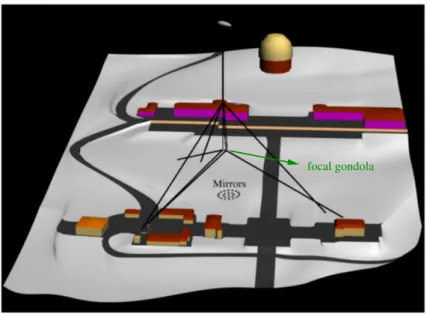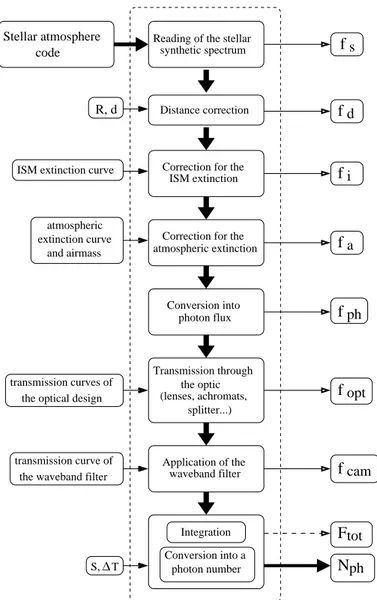Prospects for the multiplicity investigation of massive
stars with the CARLINA interferometer
Micha¨el De Becker
1,2, Herv´e Le Coroller
2and Julien Dejonghe
21Department of Astrophysics, Geophysics and Oceanography, University of Li`ege, Belgium 2 Observatoire de Haute-Provence, 04870 Saint-Michel l’Observatoire, France
Abstract: The multiwavelength study of massive stars has revealed many phenomena that are intimately related to their multiplicity. Colliding winds in massive binaries play indeed a significant role in thermal X-ray emis-sion, particle acceleration, or even dust formation in such systems. In this context, the identification of binaries and the determination of their orbital parameters is a pivotal issue. We first briefly describe the CARLINA project. The sensitivity and imaging capability of Carlina are perfectly adapted for the study of binary systems. Considering its expected specifications, Carlina will operate in complementarity with ELTs and kilometer base-line interferometers. Then, we discuss some prospects for the multiplicity investigation of massive stars, on the basis of the expected performances of the prototype currently studied at the Observatoire de Haute-Provence (OHP).
1
The Carlina concept
The Carlina design consists in a diluted aperture of spherical shape, with focal optics mounted in a balloon suspended under a gondola, or suspended under cables between two sides of a valley. One of the main advantages of such a design, with respect to other interferomtric systems, is the absence of delay lines. The apertures are anchored on the ground and positioned to constitute parts of a large spherical surface (curvature radius R=71,2 m for the OHP prototype). The light is reflected up to the focal gondola (at R/2) that contains the sphericity correctors, densified-pupil (Labeyrie 1996) and photon counting camera (Le Coroller et al. 2004). The stability of the position of the gondola is warranted by a tripod of cables whose lenght is accurately controlled by computer-controlled winches and a laser-monitored system (Le Coroller et al. 2011). A schematic view of the prototype installed at OHP is shown in Fig. 1.
1.1
Carlina prototype at OHP
At OHP, a set of three mirrors with a diameter of 25 cm is located on the ground. The 3 baselines have lengths of respectively 5, 9, and 10.5 m. Four waveband filters (width ∼ 100 nm) will be avail-able, with central wavelengths respectively of 531, 562, 624 and 692 nm (noted A, B, C, and D, respectively). It is important to emphasize that this prototype operates in the visible domain. The op-tics mounted in the gondola contains several elements whose individual transmissions are taken into
focal gondola
Figure 1: Schematic view of the OHP prototype. The relative posi-tion of the balloon and of the main buildings of the observatory are il-lustrated, along with the position of the mirrors on the ground and the tripod of cables controlling the po-sition of the gondola.
account in order to calculate the efficiency of the design, and convert it into an effective sensitivity as briefly illustrated in Fig. 2. The present design is still in development. First results for technical demonstration are expected in the forthcoming months, and should be followed by a first science ob-servation in 2011 - 2012. In the future, additional mirrors may be installed in order to characterize further the multi-aperture recombination and increase the aperture to 17 m.
1.2
Design for a 100-200 m class Carlina interferometer
Potential sites for future large Carlina interferometers have already been identified. The selection relies mainly on topographic considerations: typically, a valley oriented in the East-West direction is required, with a nearly hemi-cylindrical shape at the bottom. Such a site could be covered by a large number (100 - 1000) of small apertures. Some sites allow the focal optics to be suspended by cables, and not anymore by a balloon. The orientation of the focal optics follows the motion of the target in the East-West direction. In such a site, most of the sky would be accessible, even though the current OHP prototype is limited to a narrow sky band (see Sect. 2).
The replication of a large number of small apertures is much less expensive than the construction a large pieces of mirror. A diluted aperture design such as a Carlina interferometer constitutes an alternative architecture for hypertelescopes able to perform high angular resolution observations in the visible domain (at the sub-mas scale), without the caveat of delay-line designs used in present long baseline interferometric facilities. Carlina should be much more sensitive than conventional interferometers and will be able to obtain complex images of fainter objects (mV> 12).
2
Prospects for the multiplicity study of massive stars
A very important point to consider in the context of massive binaries is the fact that the stellar winds of the components of the system are likely to collide. This phenomenon is a key point in the physics of massive stars. This wind-wind interaction is indeed responsible for several physical processes at the front of modern stellar astrophysics research (De Becker 2010), such as copious high energy emis-sion, particle acceleration, or even dust formation. In addition, high angular resolution techniques turn out to be very valuable in order to investigate the multiplicity of massives stars. Spectroscopic techniques are indeed generally limited to shorter or medium period systems, and are strongly biased to significantly inclined systems (Sana & Le Bouquin 2010). As a complementary technique,
inter-determine their orbital parameters.
2.1
Science with the OHP prototype
The main goal of the OHP prototype is to test the optical train of an hypertelescope and to show that Carlina will be more sensitive than conventional interferometers. It is a purely technical demonstrator but it is not impossible that we will be able to make some science. To fulfill the requirement for the prototype, potential targets have to meet 4 criteria:
- angular separation: as the resolving capability is directly related to λ/D (where λ is the wave-length considered, and D is the baseline), the prototype is characterized by a well-established angular resolution. Typically, for the longest baseline, i.e. 10.5 m, we may expect an angular resolution of the order of 10 mas. This translates into an orbital separation of 10 AU for a target located at 1 kpc. Only long period systems are thus accessible, considering the typical distance to massive stars (typically a few kpc). This corresponds to a part of the orbital parameter space that is so far not sufficiently investigated by spectroscopic studies.
- brightness ratio: a secondary star in a binary system should not be too faint, with respect to the primary, in order to be detected. Typically in speckle interferometry the contrast should not be larger than 100-1000. Carlina should be able to measure small contrasts but this quantity will be determined with the OHP prototype.
- coordinates: with the present fixed apertures on the flat OHP site, the declination of the targets must lie between +40 and +50 degrees. Such a restriction would of course be lifted in a valley. - brightness: as a first approach to estimate the sensitivity of the optical design, let us consider that a target is accessible provided that the photon counting camera detects at least one photon in a sub-exposure (typically 0.001 s). Such a criterion is not fully satisfactory, but it gives a first idea of the expected capabilites of this design to detect a target in typical conditions of use.
2.2
Estimation of the photon number
We estimated the number of photons detected by the camera on the basis of synthetic stellar spectra taken from the Kurucz library (Castelli & Kurucz 2004) for a range of spectral types (O3 to O9), using typical fundamental parameters for these stars (Martins, Schaerer & Hillier 2005). In future estimates, once the specifications of the design will be more accurately characterized, more adequate synthetic spectra will be used, at least when massive stars are concerned (e.g. CMFGEN, POWR). However, at the level of accuracy of the present specifications, spectra from the Kurucz library are sufficient. The stellar spectra were corrected for ISM extinction, assuming 1 magnitude of extinction per kpc). The atmospheric extinction has also been taken into account assuming mean atmospheric conditions, i.e. averaged over many locations for moderately good weather conditions. The latter criteria translates into an extinction of 0.28 magnitude for a zenithal direction, at sea level (Green 1992). The complete procedure is summarized in Fig. 2. The aperture diameter considered is 25 cm. Fig. 3 compares the expected results, as a function of the V magnitude of the target, for two filters respectively noted A and D. Fig. 4 plots the number of photons detected for stars of spectral types O3V and O9V as a function of the distance to the target, for two filters. We see that, in typical extinction conditions, O stars might be detected with the OHP prototype provided their distance is not larger than about 4 kpc (with differences depending on the spetral type and the waveband filter used). Note that any
∆T S,
Correction for the ISM extinction Distance correction Reading of the stellar
synthetic spectrum Stellar atmosphere code Application of the waveband filter Integration Conversion into a photon number Correction for the atmospheric extinction
Conversion into photon flux
R, d
ISM extinction curve
transmission curves of the optical design
transmission curve of the waveband filter
Nph Ftot fcam fopt fph fa fi fd fs Transmission through the optic splitter...) (lenses, achromats, and airmass atmospheric extinction curve
Figure 2: Schematic view of the procedure adopted to estimate the number of photons detected by the photon counting camera, starting from stellar synthetic spectra, and taking into account interstellar and atmospheric extinctions, along with all instrumental transmissions of the optics. The different quanti-ties (noted fs, fd, fi, fa, fph, fopt,
fcam) on the right correspond to
fluxes at each step of the proce-dure. Ftot is the integrated flux (in
erg s−1cm−2), and Nph is the
num-ber of photons detected for a given collecting area (S) and a given ex-posure time (∆T).
additional extinction (due to a potential dusty molecular cloud, or any shell of circumstellar material, depending on individual targets) will affect significantly these limits.
3
Concluding remarks
We have recently succesfully tested the metrology system of Carlina (Le Coroller et al. 2011), and we are integrating the focal gondola. We should be able to observe stars in 2011-2012. Preliminary studies aiming at using the Carlina OHP-prototype are still in progress, and suggest promising results for the multiplicity investigation of massive stars. Potential targets are already identified and should be observed in the forthcoming years. The objective of these preliminary studies is to pave the way for a 100-m class Carlina interferometer, opening a new era for high angular resolution observation techniques, in complementarity with ELTs.
Acknowledgements
MD thanks the Observatoire de Haute-Provence, and especially H. Le Coroller, for his stay at OHP in 2010.
Figure 3: Estimation of the expected number of photons arriving per millisecond at the camera of the OHP prototype for an O5 spectral type, as a function of the visual magnitude (mV).
The results are given for two waveband filters centered respectively at 531 nm (filter A) and 692 nm (filter D).
Figure 4: Estimation of the expected number of photons arriving per millisecond at the camera of the OHP prototype for spectral types ranging from O3 to O9, as a function of the distance to the star, assuming a mean extinction law of 1 mag/kpc. The results are given for the two waveband filters A (left panel) and D (right panel).
References
Castelli, F., & Kurucz, R.L. 2004, Proc. IAU Symp. 210 (astro-ph/0405087) De Becker, M. 2010, RMxAC 38, 35
Green, D.W.E. 1992, International Comet Quarterly 14, 55 Labeyrie, A. 1996, A&AS 118, 517
Le Coroller, H., Dejonghe, J., Arpesella, C., Vernet, D., & Labeyrie, A. 2004, A&A 426, 721 Le Coroller, H., et al. 2011, A&A, in preparation
Martins, F., Schaerer, D., & Hillier, D.J. 2005, A&A 436, 1049 Sana, H., & Le Bourquin, J.-B. 2010, RMxAC 38, 27


